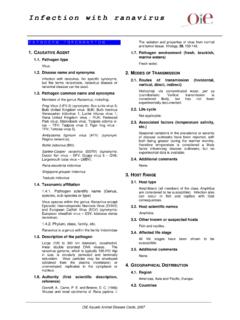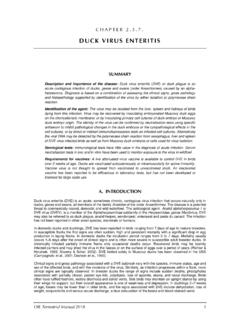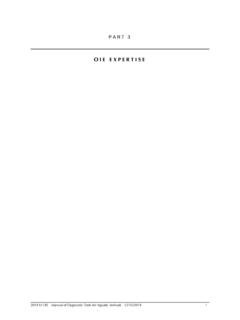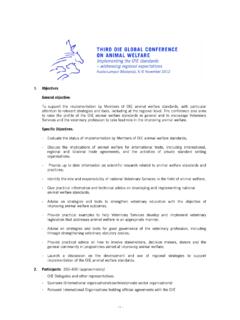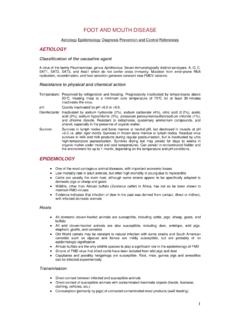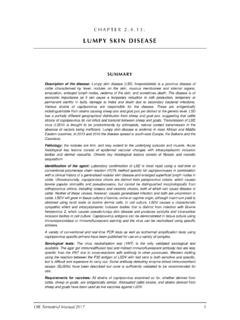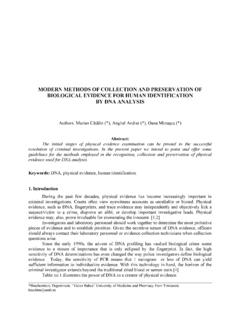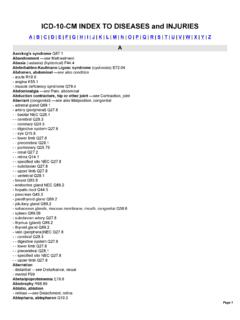Transcription of Virus survival in the environment - Home: OIE - World ...
1 Rev. sci. tech. Off. int. Epiz., 1991, 10 (3), 733-748 Virus survival in the environment PIRTLE and BERAN * Summary: Viruses pass into the environment from clinically ill or carrier hosts; although they do not replicate outside living animals or people, they are maintained and transported to susceptible hosts. Population concentrations and movement, both animal and human, have been steadily increasing in this century, enhancing transmission of respiratory and enteric viruses and compounding the difficulty of preventing environmental transmission. Studies on environmental survival factors of viruses have been most definitive for polioviruses, foot and mouth disease viruses and Aujeszky's disease Virus .
2 In addition, heat resistance studies have been reported on adenoviruses, African swine fever Virus and the Norwalk Virus . Resistance to disinfectants has been studied for many viruses, including picornaviruses, papovaviruses, reoviruses and retroviruses. survival of viruses in and on a variety of fomites has been studied for influenza viruses, paramyxoviruses, poxviruses and retroviruses. The subacute spongiform encephalopathy agents, under extensive current studies, are being found to have incredible stability in the environment . KEYWORDS: environment - Fomites - Inactivation - Resistance - Stability - survival - Virus . INTRODUCTION In the triad of infectious disease transmission involving aetiological agents, susceptible hosts and the environment , the role of the environment is the most ambiguous.
3 The environment receives, maintains or protects and transports aetiological agents to susceptible hosts. Viruses may enter the environment in enormous quantities from clinically ill or inapparent carrier hosts; when extant outside the hosts which support their replication, they are the least understood of infectious agents. The greatest prospects for disease control for the future, however, lie in environmental measures to halt or reduce transmission. Conversely, failure to break the chains of transmission will result from failure to protect the environment or to modify it beneficially. The increase in respiratory disease transmission through population concentrations, in cities in the case of humans and in confinement production units in the case of animals, is the most striking example of disease prevalence.
4 A greater contemporary awareness of the role played by the confined environment in increasing the transmission of some diseases while reducing that of others has prompted more serious study of the environment . * Department of Microbiology, Immunology and Preventive Medicine, College of Veterinary Medicine, Iowa State University, Ames, Iowa 50011, United States of America. 734 This review of the survival of viruses in the environment attempts to consolidate data from reported studies. Further investigation of how numerous viruses survive in the environment is necessary. Current knowledge is fragmented and the fragments differ widely according to the infectious agents; this fact highlights the need for more comprehensive studies in the future. This article discusses viral entry, survival and transport as they relate to any nonliving substances or living organisms which do not support viral replication.
5 Viruses are considered by families and are ordered alphabetically. When more than one Virus is discussed in a chapter, they are considered alphabetically in relation to the first Virus mentioned in the chapter. ADENOVIRIDAE Thermal inactivation studies have been reported for adenovirus 12, reovirus 1 and herpes simplex Virus in raw milk, sterilized homogenized milk, raw chocolate milk and raw ice cream mix, with minimum essential medium (MEM) as control suspending fluid (55, 57). From approximately 10,000 plaque-forming units (PFU) per ml of each suspending medium, inactivation curves at 40 C-60 C were asymptotic to the base line, indicating that small amounts of these viruses survived, even at the higher temperature. At 65 C, the inactivation curves approached first order reactions, indicating that temperatures near pasteurization standards were effective in inactivating these three viruses.
6 In the same studies, influenza A and Newcastle disease viruses showed stability in raw and sterilized milk equivalent to that in MEM. Thermal inactivation of Maloney Virus , Rauscher leukemia Virus and Rous sarcoma Virus assayed in mice showed Rous sarcoma to be the most resistant. ARENAVIRIDAE The hallmark of all rodent-borne arenaviruses is persistent infection in the rodent host in the presence of immunological response (38). Persistence is established in the natural host if Virus transmission occurs in utero or shortly after birth. Most persistently infected rodents have permanent viruria and viremia. Viral persistence is a highly efficient means of Virus perpetuation in most rodent offspring; it is also the most important source of contamination of the external environment and leads to transmission of infection.
7 HERPESVIRIDAE Extensive studies have been published on assays of potentially contaminated fomites for both human and animal herpesviruses. Additional studies of Virus survival on and in experimentally-contaminated fomites have been reported. In studies on the alphaherpesvirus, HSV2, assays of spa water failed to yield the Virus (45). To 735 simulate the conditions of survival of HSV2 on plastic-coated benches and seats in spa facilities, HSV2 (104-2 CCID50 ml) was placed on plastic surfaces in a humid atmosphere at 37 C-40 C. The Virus was found to survive for up to h under these conditions. The results of a study with HSV1 and HSV2 viruses demonstrated that HSV obtained directly from ulcerative or vesicular genital lesions was able to survive for several hours on fomites and hard surfaces and for several days on dry cotton gauze (35).
8 HSV2 has been shown to survive for short periods outside the host; it is the opinion of some workers, however, that while the Virus can persist on certain surfaces and porous items, such as towels, for relatively long periods of time, fomites are not particularly significant in transmission (22). There has been considerable interest in environmental transmission of the betaherpesvirus, cytomegalovirus (CMV), among infants and personnel in medical facilities. During a four-month study, CMV was found in the urine of eight infants (54). Three of the isolates were found to be identical by restriction endonuclease analysis, which suggests that the three infants in question were infected with the same CMV strain. The evidence indicates that CMV was transmitted from one infant to the other two infants through unidentified fomites within the nursery.
9 Samples from the immediate environment of these eight CMV-infected infants were obtained and submitted for Virus assay in cell cultures (23). CMV was isolated from those objects which had come in direct contact with infected secretions, from six of eight oronasal suction bulbs, one feeding tube, four dry diapers in contact with genitalia, and from a pair of gloves worn by a nurse. While the conclusion was reached that CMV could be isolated for several hours after natural contamination, it was not determined that fomites were an important source of nosocomial CMV transmission. That personnel should wash their hands during patient care, however, was considered as essential. Nosocomial transmission of CMV was investigated in a chronic care unit (CMV excretion prevalence 16%) and a neonatal unit (CMV excretion prevalence ) (19).
10 In the chronic care unit, two infants were infected with homologous strains of CMV. No infants acquired CMV in the neonatal unit of the hospital, though seroconversion did occur in two nurses. CMV was isolated from diapers and from the hands of patients and personnel, but not from environmental surfaces. In an epidemiological study of bovine herpes mammillitis (BHM) Virus (27), pseudocowpox was confirmed in dual infections in nine of eleven BHM-positive milking herds. The pattern of BHM spread was not related to the incidence of pseudocowpox or to the order in which cows were milked. Meteorological data suggested that BHM occurred more frequently in those years conducive to the increase of large populations of insect vectors, and that the direction in which BHM spread to herds within a locality was related to the predominant wind direction.

